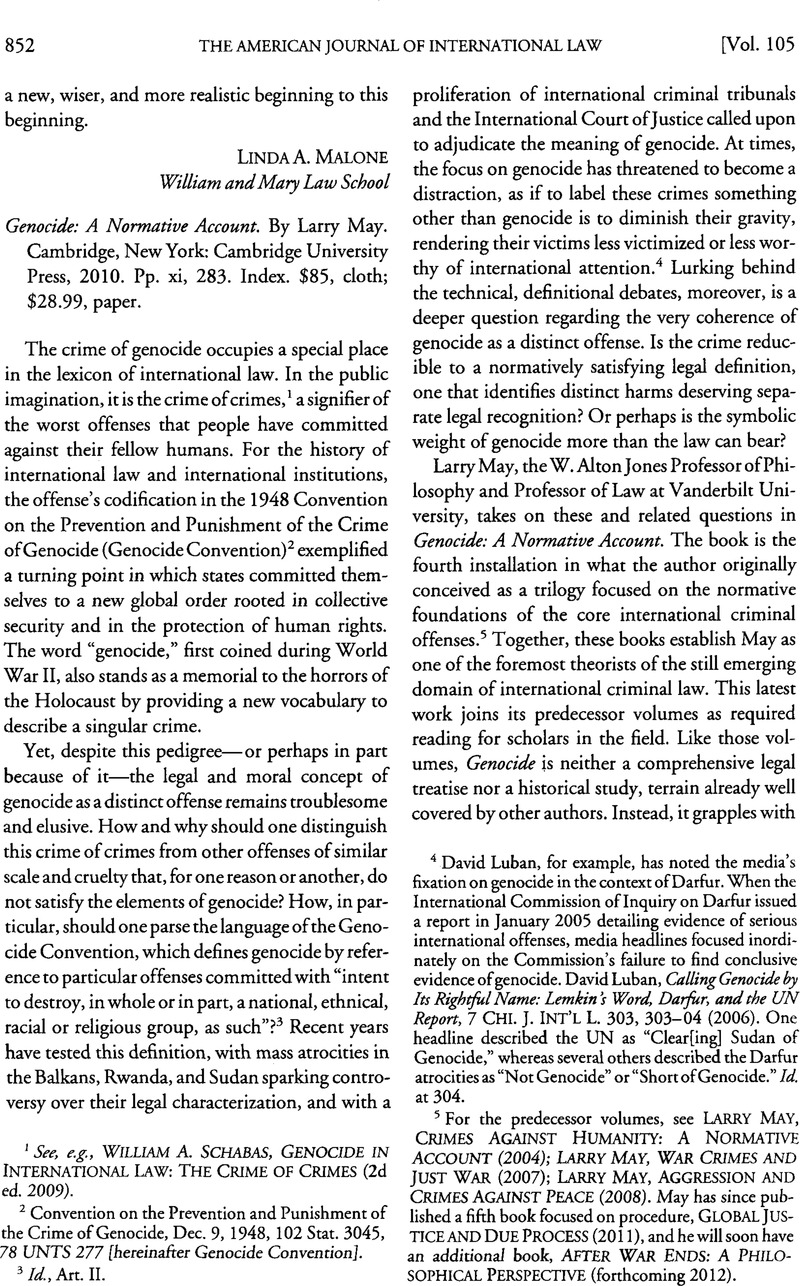No CrossRef data available.
Article contents
Genocide: A Normative Account. By Larry May. Cambridge, New York: Cambridge University Press, 2010. Pp. xi, 283. Index. $85, cloth; $28.99, paper.
Published online by Cambridge University Press: 02 March 2017
Abstract

- Type
- Recent Books on International Law
- Information
- Copyright
- Copyright © American Society of International Law 2011
References
1 See, e.g., Schabas, William A., Genocide in International Law: The Crime of Crimes (2d ed. 2009)Google Scholar.
2 Convention on the Prevention and Punishment of the Crime of Genocide, Dec. 9, 1948, 102 Stat. 3045, 78 UNTS 277 [hereinafter Genocide Convention].
3 Id., Art. II.
4 David Luban, for example, has noted the media’s fixation on genocide in the context of Darfur. When the International Commission of Inquiry on Darfur issued a report in January 2005 detailing evidence of serious international offenses, media headlines focused inordinately on the Commission’s failure to find conclusive evidence of genocide. Luban, David, Calling Genocide by Its Rightful Name: Lemkin’s Word, Darfur, and the UN Report , 7 Chi. J. Int’l L. 303, 303-04 (2006)Google Scholar. One headline described the UN as “Clear[ing] Sudan of Genocide,” whereas several others described the Darfur atrocities as “Not Genocide” or “Short of Genocide.” Id. at 304.
5 For the predecessor volumes, see May, Larry, Crimes Against Humanity: A Normative Account (2004); Larry May, War Crimes and Just War (2007)Google Scholar; May, Larry, Aggression and Crimes Against Peace (2008)Google Scholar. May has since published a fifth book focused on procedure, Global Justice and Due Process (2011), and he will soon have an additional book, After War Ends: A Philosophical Perspective (forthcoming 2012).
6 May explains that “it also seems sensible to say that a person who has lost a significant group affiliations before death has a worse death than a person who does not” (p. 87).
7 Convention on the Prevention and Punishment of the Crime of Genocide, Secretariat Draft, UN Doc. E/447 (May 1947); see also GA Res. 96 (I) (Dec. 11, 1946) (“Genocide. . .results in great losses to humanity in the form of cultural and other contributions represented by these human groups.”). This rationale traces back to work of Raphael Lemkin, who both coined the term “genocide” and spearheaded the movement to establish genocide as an international crime. Lemkin reasoned that “the world represents only so much culture and intellectual vigor as are created by its component national groups. Essentially the idea of a nation signifies constructive cooperation and individual contributions, based upon genuine traditions, genuine culture, and a well-developed national psychology. The destruction of a nation, therefore, results in the loss of its future contributions to the world.” Raphael Lemkin, Axis Rule IN Occupied Europe 91 (1944) (footnote omitted).
8 See Prosecutor v. Akayesu, No. ICTR-96-4-T, Judgment, paras. 170-71 (Sept. 2, 1998).
9 As noted, the Genocide Convention defines genocide’s mens rea by reference to an “intent to destroy, in whole or in part, a national, ethnical, racial or religious group, as such.” Genocide Convention, supra note 2, Art. II.
10 See Alexander K. A., Greenawalt, Rethinking Genocidal Intent: The Case for a Knowledge-Based Interpretation, 99 Colum. L. Rev. 2259 (1999)Google Scholar.
11 I choose to focus here on May’s argument that” [i] t is indeed crucial that there be a plan that has as its purpose the destruction of a protected group in whole or in substantial part” (p. 126). I do not here address May’s additional arguments regarding what is, in my view, the less central question of what individual mens rea is required to attach culpability to individual participants in such a plan.
12 See Greenawalt, supra note 10, at 2270-79.
13 In this context May quotes Prosecutor v. Krstić, Judgment, No. IT-98-33-A, para. 134 (Apr. 19, 2004) (p. 128).
14 Prosecutor v. Al Bashir, No. ICC-02/05-01/09-3, Decision on the Prosecutor’s Application for a Warrant ofArrest Against Omar Hassan Ahmed Al Bashir, para. 135 (Mar. 4, 2009). The ICC appeals chamber subsequently reversed the trial chamber ruling on the unrelated ground of having applied the wrong burden of proof at the pretrial stage. See Prosecutor v. Al Bashir, No. ICC-02/05-01 /09-OA, Judgment on the Appeal of the Prosecutor Against the “Decision on the Prosecution’s Application for a Warrant ofArrest Against Omar Hassan Ahmed Al Bashir” (Feb. 3, 2010).
15 Most notably, in ruling that the murder of 8,000 men in and around Srebrenica reflected genocidal intent, an ICTY trial chamber observed that the “Bosnian Serb forces could not have failed to know, by the time they decided to kill all the men, that this selective destruction of the group would have a lasting impact upon the entire group.” Krstić, No. IT 98-33-T, Judgment, para. 595 (Aug. 1, 2001). Elsewhere in the same decision, however, the same trial chamber expressly rejected the view that mere awareness of group destruction is sufficient for genocidal intent. Id., para. 571.
16 See also Genocide Convention, supra note 2, Art. 11(e).
17 See Dubber, Markus, Criminalizing Complicity: A Comparative Analysis, 5 J. Int’l Crim. Just. 977 (2007)Google Scholar. I have argued elsewhere that international law does not have the same stake in resolving differences among domestic approaches to the general part of criminal law—including modes of liability—as it does in defining international offenses such as genocide, crimes against humanity, and war crimes. See Alexander K. A., Greenawalt, The Pluralism of International Criminal Law, 86 Ind. L.J. 1063 (2011)Google Scholar.
18 Convention, Genocide, supra note 2, Art. III. 19 See, e.g., SCHABAS, supra note 1, at 351-55, 361-66Google Scholar. 20 See Luban, supra note 4, at 319-20.
19 See, e.g., Schabas, supra note 1, at 351-55, 361-66.
20 See Luban, supra note 4, at 319-20.




